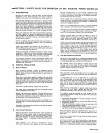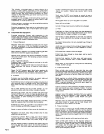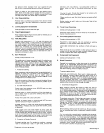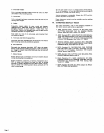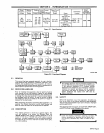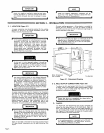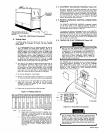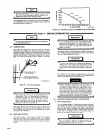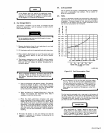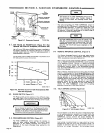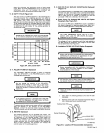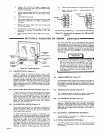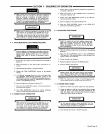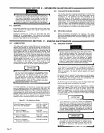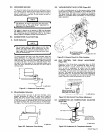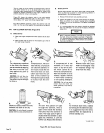
4-4.
AIR
CLEANER
NOTE
If
the
battery
does
not
require
any
additional
charg
ing,
the
only
step
required
to
place
the
battery
into
operation
is
to
connect
the
negative
()
battery
cable
to
the
negative
()
terminal
on
the
battery.
B.
Dry
Charged
Battery
This
battery
is
shipped
in
a
dry
state.
To
prepare
the
new
battery
for
operation,
it
will
be
necessary
to
obtain
electro
lyte,
proceed
as
follows:
Put
on
protective
eye
cover
and
clothing
prior
to
pour
ing
the
electrolyte
solution.
1.
Remove
the
battery
from
the
unit
and
place
it
on
a
level
work
table
or
other
suitable
area.
2.
Fill
the
battery
cells
to
the
required
level
with
electrolyte.
3.
Place
a
battery
thermometer
in
one
of
the
center
calls
and
check
the
specific
gravity
of
each
cell
with
a
battery
hydrometer.
4.
The
battery
temperature
must
be
80F
and
the
specific
gravity
reading
1.260
prior
to
installation.
If
both
condi
tions
are
not
met,
charge
the
battery
following
the
in
structions
below:
to
cha
rging
t
he
batte:
the
baft
ery
caps
m!st
be
removed.
Failure
to
remove
the
caps
could
result
in
the
battery
exploding
should
the
battery
be
over
charged.
a.
Use
an
automotive
type
battery
charger.
This
battery
should
be
charged
at
about
a
3.5
ampere
rate
until
correct
electrolyte
conditions
are
met.
Lower
charging
rates
can
be
used;
however,
the
time
to
obtain
the
correct
electrolyte
conditions
will
be
longer.
The
air
cleaner
this
engine
is
equipped
with,
is
a
dry
element
type
with
a
replaceable
filter
element.
The
air
cleaner
re
quires
no
initial
service.
4-5.
FUEL
Figure
4-2
illustrates
typical
fuel
consumption
under
specific
load
conditions.
Fuel
consumption
will
vary
from
one
engine
to
another.
Different
brands
of
fuel,
operating
conditions,
condition
of
the
engine,
and
many
other
conditions
will
af
fect
the
fuel
consumption
of
this
engine.
_j
IC
~
0
U
-J
1.0
2.5
4.0
6.0
9.0
12.0
POWER
KVA
AT
100%
DUTY
CYCLE
(I!
AVAILAILI)
Figure
4-2.
Fuel
Consumption
Chart
1IIC~UiR.
Do
not
attempt
to
fill
the
fuel
tank
with
the
engine
running.
Do
not
fill
the
fuel
tank
completely
as
cold
fuel
will
expand
when
exposed
to
outside
temperature
in
a
warm
climate
or
to
engine
heat,
If
the
thnk
is
too
full
it
will
overflow
causing
a
potential
fire
hazard.
Never
allow
fuel
to
drain
on
the
engine
or
other
com
ponents.
b.
When
the
battery
is
charged,
disconnect
it
from
the
charger
and
re.check
the
electrolyte
level.
Add
if
necessary.
Install
the
battery
caps.
c.
Rinse
the
empty
electrolyte
containers
with
water
before
discarding.
Since
battery
acid
is
corrosive
to
metals,
do
not
pour
into
a
metal
sink
or
drain.
Rinse
and
mutilate
the
empty
electrolyte
container
before
discarding.
If
acid
has
accidentally
spilled
on
the
bat
tery
or
work
area
during
filling
or
charging,
flush
off
with
clear
water
and
neutralize
with
soda
or
ammonia
solution.
Use
the
same
procedure
if
add
is
spilled
on
clothing.
5.
Re-install
the
battery
in
the
unit
making
sure
that the
negative
()
terminal
of
the
battery
is
connected
to
the
negative
()
battery
cable.
The
fuel
tank
is
equipped
with
a
trap
area
in
the
bottom
of
the
tank,
therefore;
the
tank
will
not
go
completely
dry.
This
trap
holds
water
and
dirt
back
from
the
engine.
A
drain
plug
is
located
on
the
left,
bottom
of
the
tank
to
drain
water
and
dirt
from
the
tank
if
it
should
become
necessary.
I
I
IMPORTANT
Use
a
good
grade
of
regular
gasoline,
rated
at
least
at
85
octane,
for
this
engine.
Fuels
of
lower
octane
ratings
may
cause
detonations
(knocking)
which
could
result
in
damage
to
the
engine.
The
fuel
capacity
of
the
fuel
tank
is
17.5
gallons
(U.S.
Measure).
I
I
.
I
11.35
10.4
9.46
8.52
7.57
6.62
5.67
4.73
3.78
2.84
1.98
.95
2.5
2.29
2.08
1.87
1.7
1.46
1.25
1.04
0.83
0.62
0.4
0.21
3.0
2.75
2.5
2.25
2.0
1.75
1.5
1.25
1.0
0.75
0.5
0.25
50
100
150
200
250
300
350
400
D.C.
WELD
AMPERES
AT
100
DUTY
CYCLE
WELD
6-005
606
OM-457
Pa~
9



